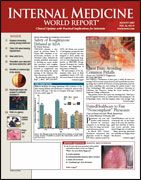Publication
Article
Internal Medicine World Report
Few Hypertensive Patients Follow DASH
Author(s):
Counsel Your Patients on Diet, a Well-Proven Guideline
By Wayne Kuznar
CHICAGO—Few patients with hypertension are following the DASH diet, said Philip Mellen, MD, MS, at the American Society of Hypertension annual meeting.
DASH stands for Dietary Approaches to Stop Hypertension. A 1997 trial by this name showed that a diet rich in fruits, vegetables, grains, and low-fat dairy products that was low in fat, cholesterol, and sodium reduced systolic blood pressure (BP) in hypertensive individuals by 11.4 mm Hg and diastolic BP by 5.5 mm Hg.
In an analysis of the National Health and Nutrition Examination Survey (NHANES) from 1999 to 2004, which was conducted at least 2 years after the DASH trial, only about 1 in 5 hypertensive adults reported following the DASH diet.
The DASH diet was among the therapeutic lifestyle changes recommended by national hypertension guidelines (Joint National Committees 6 and 7) for all patients with hypertension or at risk of hypertension, regardless of antihypertensive drug therapy, noted Dr Mellen, assistant professor of internal medicine, Wake Forest University, Winston-Salem, NC.
"The dietary quality of hypertensive adults has appeared to deteriorate since the DASH diet became incorporated into national guidelines," he said.
He and colleagues compared compliance with the DASH diet components among 2 groups of NHANES hypertensive participants: 4556 individuals who took the survey between 1988 and 1994 (3 years before publication of the DASH results) and another 4386 individuals who participated in NHANES from 1999 to 2004.
Nine components of the DASH diet were targeted: intake of saturated fat, total fat, sodium, cholesterol, protein, fiber, magnesium, calcium, and potassium. Those who met about one half of the targets were considered accordant with the DASH diet.
P
During the 1999-2004 survey, 21.7% of those with known hypertension were accordant with DASH. This proportion was 7.6% lower ( = .002) than that in the previous survey.
The difference was partially explained by fewer patients meeting dietary targets for fat, fiber, and magnesium.
P
P
P
In the earlier survey, 42.9% of the hypertensive participants met the target for total fat, compared with only 35.9% in the recent survey ( = .01). The target for fiber intake was met by 20.2% in the earlier survey and 12.3% in the recent survey ( <.001), and the target for magnesium intake was met by 14.2% in the earlier survey and only 6.4% in the recent survey ( <.001).
After adjusting for potential confounders, blacks had 39% lower odds of accordance with DASH than non-Hispanic whites, and those with post?high school education had 80% greater odds of accordance compared with those with only a high school diploma. Patients with diabetes were 53% more likely to follow DASH than those without diabetes. Those older than 60 years were almost 4 times as likely, and those aged 40 to 59 years were almost 3 times as likely, to follow the DASH diet compared with 20- to 39-year-old persons.
Dr Mellen said several factors probably play a role in the low accordance with the DASH diet. "Physicians don't feel adequately trained to do this [dietary counseling], and dietary counseling is not allowed for in the reimbursement structure. It requires a significant investment in time for physicians," he said. "All in all, it may appear easier to give a prescription."





